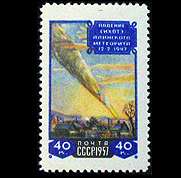If Fortune Smiles, Keep Your Eyes Wide Open
When a meteoroid passes through the atmosphere, it can be seen across several provinces and states. Each observer has the impression that the meteorite is falling very close to him or her. Fireballs always appear closer than they really are, because it is difficult to judge the distance that separates us from such phenomena, especially at night.
If you witness the passage of a fireball and you want to be able to give a good description of it, you'll need to note the following details:
- your exact position;
- the day, the time, and the duration of your observation;
- the intensity, the dimensions, and the colour of the light observed;
- the direction and angle of the fireball in relation to a fixed point such as a house or a mountain;
- any accompanying sounds.

Enlargement
On February 12, 1947, an artist named Medvedev was set up to paint a landscape. Witnessing the fall of Sikhote-Alin, he depicted the event. His painting was published on a postage stamp. |
If you think you have found a meteorite, pick it up wearing gloves or using a plastic bag to avoid contaminating it, and, most important, keep it in a dry place. You would probably expect a meteorite that has just fallen to be hot, but this is not the case. Although the crust heats up as it passes through the atmosphere, it cools down quickly because the inside of the meteorite is as cold as space (–170°C). After its fall, the meteorite takes several minutes to reach the surrounding temperature. If you touch it before then, the burning sensation you feel will be caused by the intense cold.
On January 4, 2004, in León, Spain, a spectator watching a parade captured the passage of a fireball on video . The fireball's trajectory was then calculated, and meteorite fragments were found in Villalbeto de la Peña.
Courtesy of NOS Dutch television
|